ACC203 Management Accounting: Factors, Qantas & Balanced Scorecard
VerifiedAdded on 2023/06/03
|6
|1672
|195
Report
AI Summary
This report provides a comprehensive analysis of management accounting practices, focusing on factors contributing to their development and the application of the balanced scorecard. Part A discusses the shift in management accounting due to external and internal factors, highlighting the importance of competitive support and strategic objectives. It also evaluates the usefulness of the balanced scorecard as a strategic performance management tool. Part B applies these concepts to Qantas, identifying its critical success factors (CSFs) and key performance indicators (KPIs), constructing a strategy map aligned with Qantas's long-term objectives, and developing a balanced scorecard based on the analysis. The report concludes with a list of references.
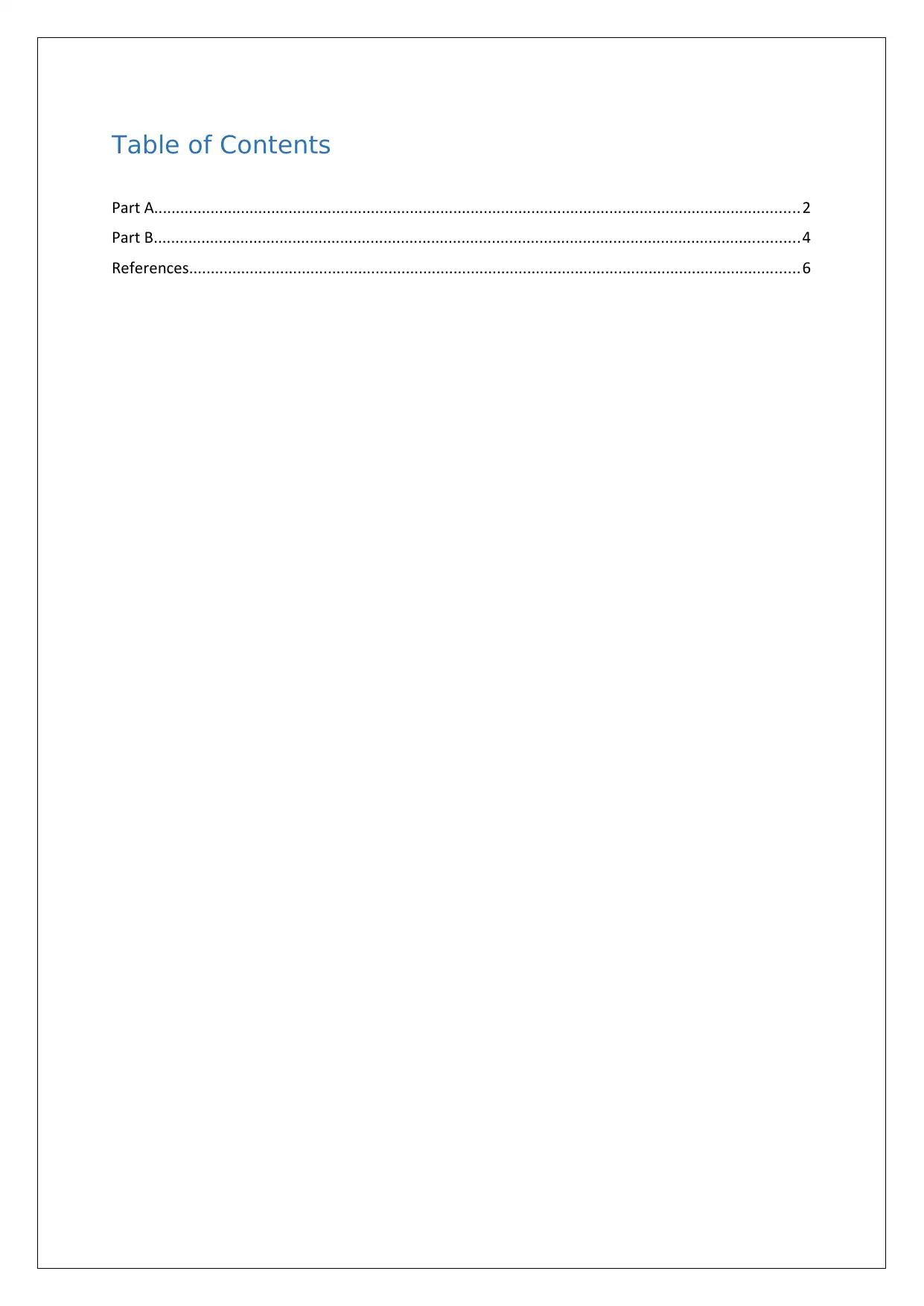
Table of Contents
Part A.....................................................................................................................................................2
Part B.....................................................................................................................................................4
References.............................................................................................................................................6
Part A.....................................................................................................................................................2
Part B.....................................................................................................................................................4
References.............................................................................................................................................6
Paraphrase This Document
Need a fresh take? Get an instant paraphrase of this document with our AI Paraphraser
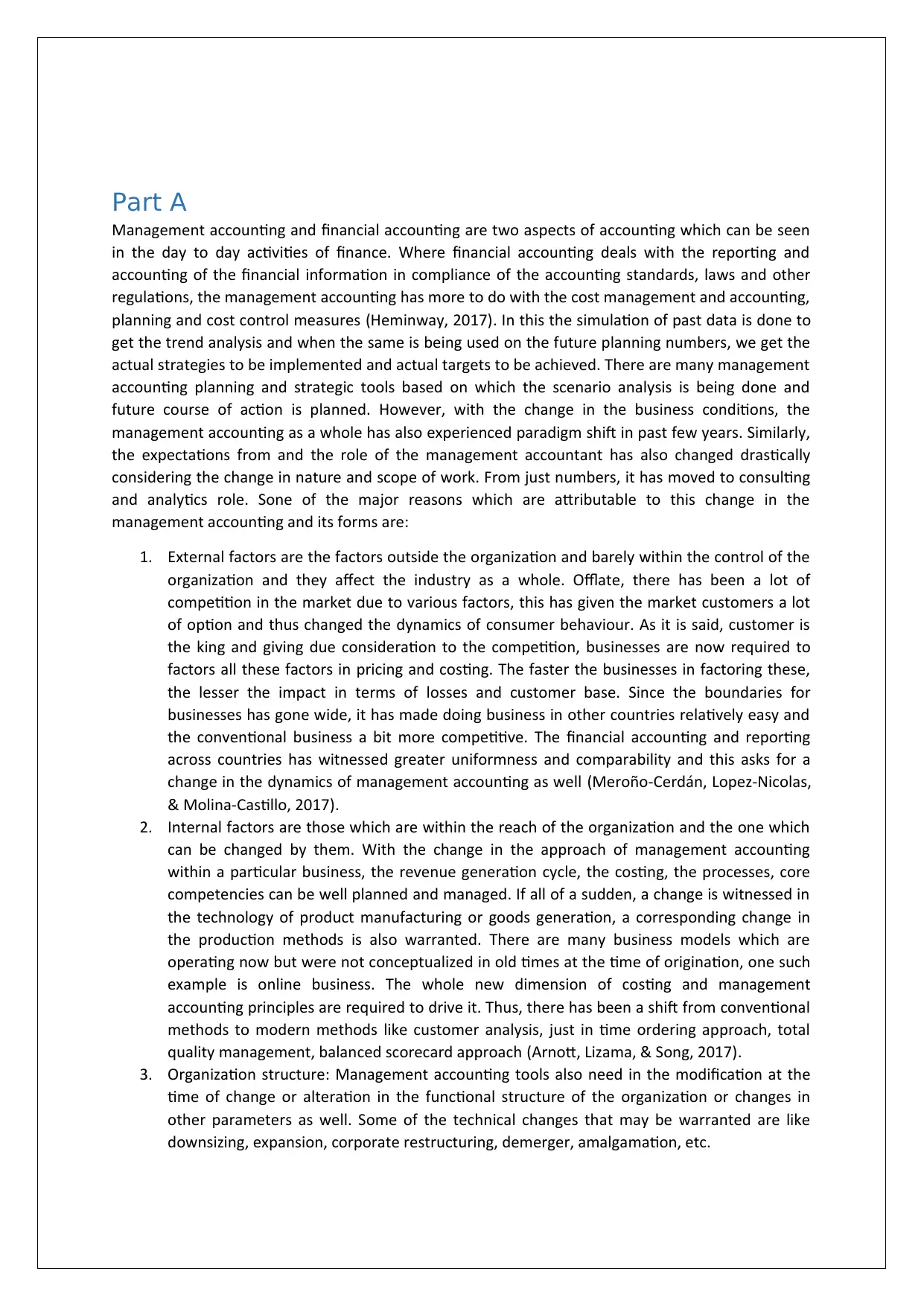
Part A
Management accounting and financial accounting are two aspects of accounting which can be seen
in the day to day activities of finance. Where financial accounting deals with the reporting and
accounting of the financial information in compliance of the accounting standards, laws and other
regulations, the management accounting has more to do with the cost management and accounting,
planning and cost control measures (Heminway, 2017). In this the simulation of past data is done to
get the trend analysis and when the same is being used on the future planning numbers, we get the
actual strategies to be implemented and actual targets to be achieved. There are many management
accounting planning and strategic tools based on which the scenario analysis is being done and
future course of action is planned. However, with the change in the business conditions, the
management accounting as a whole has also experienced paradigm shift in past few years. Similarly,
the expectations from and the role of the management accountant has also changed drastically
considering the change in nature and scope of work. From just numbers, it has moved to consulting
and analytics role. Sone of the major reasons which are attributable to this change in the
management accounting and its forms are:
1. External factors are the factors outside the organization and barely within the control of the
organization and they affect the industry as a whole. Offlate, there has been a lot of
competition in the market due to various factors, this has given the market customers a lot
of option and thus changed the dynamics of consumer behaviour. As it is said, customer is
the king and giving due consideration to the competition, businesses are now required to
factors all these factors in pricing and costing. The faster the businesses in factoring these,
the lesser the impact in terms of losses and customer base. Since the boundaries for
businesses has gone wide, it has made doing business in other countries relatively easy and
the conventional business a bit more competitive. The financial accounting and reporting
across countries has witnessed greater uniformness and comparability and this asks for a
change in the dynamics of management accounting as well (Meroño-Cerdán, Lopez-Nicolas,
& Molina-Castillo, 2017).
2. Internal factors are those which are within the reach of the organization and the one which
can be changed by them. With the change in the approach of management accounting
within a particular business, the revenue generation cycle, the costing, the processes, core
competencies can be well planned and managed. If all of a sudden, a change is witnessed in
the technology of product manufacturing or goods generation, a corresponding change in
the production methods is also warranted. There are many business models which are
operating now but were not conceptualized in old times at the time of origination, one such
example is online business. The whole new dimension of costing and management
accounting principles are required to drive it. Thus, there has been a shift from conventional
methods to modern methods like customer analysis, just in time ordering approach, total
quality management, balanced scorecard approach (Arnott, Lizama, & Song, 2017).
3. Organization structure: Management accounting tools also need in the modification at the
time of change or alteration in the functional structure of the organization or changes in
other parameters as well. Some of the technical changes that may be warranted are like
downsizing, expansion, corporate restructuring, demerger, amalgamation, etc.
Management accounting and financial accounting are two aspects of accounting which can be seen
in the day to day activities of finance. Where financial accounting deals with the reporting and
accounting of the financial information in compliance of the accounting standards, laws and other
regulations, the management accounting has more to do with the cost management and accounting,
planning and cost control measures (Heminway, 2017). In this the simulation of past data is done to
get the trend analysis and when the same is being used on the future planning numbers, we get the
actual strategies to be implemented and actual targets to be achieved. There are many management
accounting planning and strategic tools based on which the scenario analysis is being done and
future course of action is planned. However, with the change in the business conditions, the
management accounting as a whole has also experienced paradigm shift in past few years. Similarly,
the expectations from and the role of the management accountant has also changed drastically
considering the change in nature and scope of work. From just numbers, it has moved to consulting
and analytics role. Sone of the major reasons which are attributable to this change in the
management accounting and its forms are:
1. External factors are the factors outside the organization and barely within the control of the
organization and they affect the industry as a whole. Offlate, there has been a lot of
competition in the market due to various factors, this has given the market customers a lot
of option and thus changed the dynamics of consumer behaviour. As it is said, customer is
the king and giving due consideration to the competition, businesses are now required to
factors all these factors in pricing and costing. The faster the businesses in factoring these,
the lesser the impact in terms of losses and customer base. Since the boundaries for
businesses has gone wide, it has made doing business in other countries relatively easy and
the conventional business a bit more competitive. The financial accounting and reporting
across countries has witnessed greater uniformness and comparability and this asks for a
change in the dynamics of management accounting as well (Meroño-Cerdán, Lopez-Nicolas,
& Molina-Castillo, 2017).
2. Internal factors are those which are within the reach of the organization and the one which
can be changed by them. With the change in the approach of management accounting
within a particular business, the revenue generation cycle, the costing, the processes, core
competencies can be well planned and managed. If all of a sudden, a change is witnessed in
the technology of product manufacturing or goods generation, a corresponding change in
the production methods is also warranted. There are many business models which are
operating now but were not conceptualized in old times at the time of origination, one such
example is online business. The whole new dimension of costing and management
accounting principles are required to drive it. Thus, there has been a shift from conventional
methods to modern methods like customer analysis, just in time ordering approach, total
quality management, balanced scorecard approach (Arnott, Lizama, & Song, 2017).
3. Organization structure: Management accounting tools also need in the modification at the
time of change or alteration in the functional structure of the organization or changes in
other parameters as well. Some of the technical changes that may be warranted are like
downsizing, expansion, corporate restructuring, demerger, amalgamation, etc.
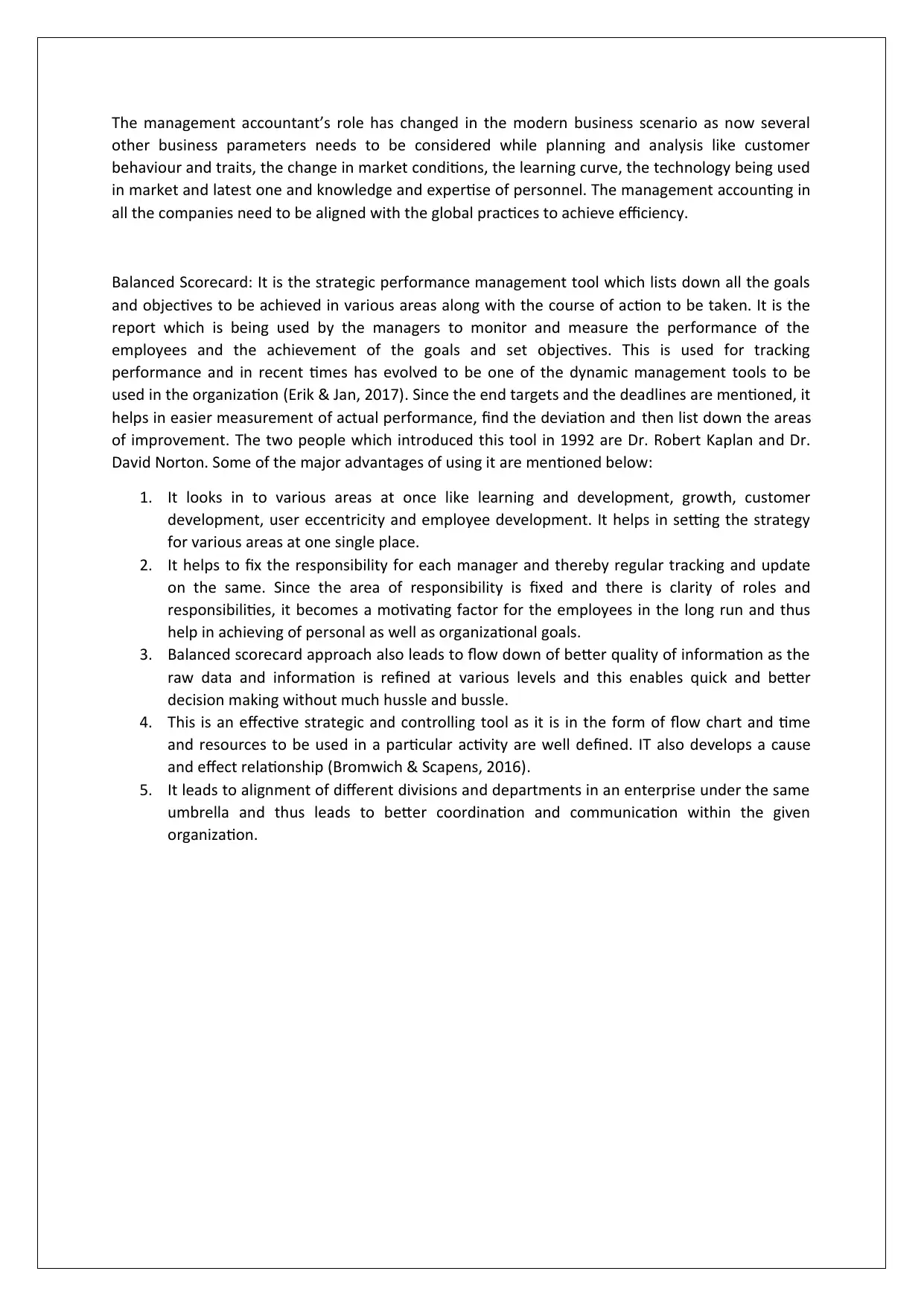
The management accountant’s role has changed in the modern business scenario as now several
other business parameters needs to be considered while planning and analysis like customer
behaviour and traits, the change in market conditions, the learning curve, the technology being used
in market and latest one and knowledge and expertise of personnel. The management accounting in
all the companies need to be aligned with the global practices to achieve efficiency.
Balanced Scorecard: It is the strategic performance management tool which lists down all the goals
and objectives to be achieved in various areas along with the course of action to be taken. It is the
report which is being used by the managers to monitor and measure the performance of the
employees and the achievement of the goals and set objectives. This is used for tracking
performance and in recent times has evolved to be one of the dynamic management tools to be
used in the organization (Erik & Jan, 2017). Since the end targets and the deadlines are mentioned, it
helps in easier measurement of actual performance, find the deviation and then list down the areas
of improvement. The two people which introduced this tool in 1992 are Dr. Robert Kaplan and Dr.
David Norton. Some of the major advantages of using it are mentioned below:
1. It looks in to various areas at once like learning and development, growth, customer
development, user eccentricity and employee development. It helps in setting the strategy
for various areas at one single place.
2. It helps to fix the responsibility for each manager and thereby regular tracking and update
on the same. Since the area of responsibility is fixed and there is clarity of roles and
responsibilities, it becomes a motivating factor for the employees in the long run and thus
help in achieving of personal as well as organizational goals.
3. Balanced scorecard approach also leads to flow down of better quality of information as the
raw data and information is refined at various levels and this enables quick and better
decision making without much hussle and bussle.
4. This is an effective strategic and controlling tool as it is in the form of flow chart and time
and resources to be used in a particular activity are well defined. IT also develops a cause
and effect relationship (Bromwich & Scapens, 2016).
5. It leads to alignment of different divisions and departments in an enterprise under the same
umbrella and thus leads to better coordination and communication within the given
organization.
other business parameters needs to be considered while planning and analysis like customer
behaviour and traits, the change in market conditions, the learning curve, the technology being used
in market and latest one and knowledge and expertise of personnel. The management accounting in
all the companies need to be aligned with the global practices to achieve efficiency.
Balanced Scorecard: It is the strategic performance management tool which lists down all the goals
and objectives to be achieved in various areas along with the course of action to be taken. It is the
report which is being used by the managers to monitor and measure the performance of the
employees and the achievement of the goals and set objectives. This is used for tracking
performance and in recent times has evolved to be one of the dynamic management tools to be
used in the organization (Erik & Jan, 2017). Since the end targets and the deadlines are mentioned, it
helps in easier measurement of actual performance, find the deviation and then list down the areas
of improvement. The two people which introduced this tool in 1992 are Dr. Robert Kaplan and Dr.
David Norton. Some of the major advantages of using it are mentioned below:
1. It looks in to various areas at once like learning and development, growth, customer
development, user eccentricity and employee development. It helps in setting the strategy
for various areas at one single place.
2. It helps to fix the responsibility for each manager and thereby regular tracking and update
on the same. Since the area of responsibility is fixed and there is clarity of roles and
responsibilities, it becomes a motivating factor for the employees in the long run and thus
help in achieving of personal as well as organizational goals.
3. Balanced scorecard approach also leads to flow down of better quality of information as the
raw data and information is refined at various levels and this enables quick and better
decision making without much hussle and bussle.
4. This is an effective strategic and controlling tool as it is in the form of flow chart and time
and resources to be used in a particular activity are well defined. IT also develops a cause
and effect relationship (Bromwich & Scapens, 2016).
5. It leads to alignment of different divisions and departments in an enterprise under the same
umbrella and thus leads to better coordination and communication within the given
organization.
⊘ This is a preview!⊘
Do you want full access?
Subscribe today to unlock all pages.

Trusted by 1+ million students worldwide
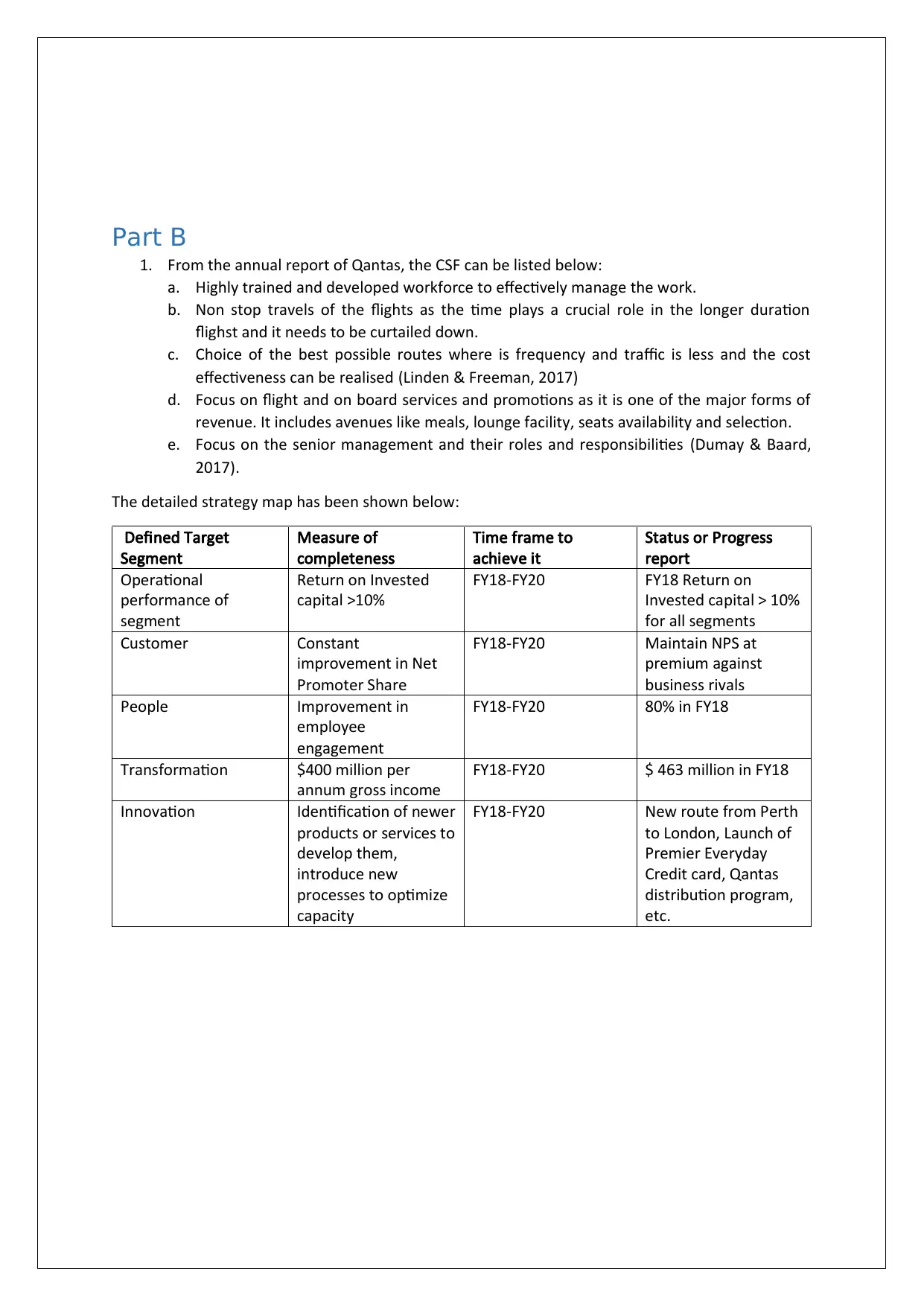
Part B
1. From the annual report of Qantas, the CSF can be listed below:
a. Highly trained and developed workforce to effectively manage the work.
b. Non stop travels of the flights as the time plays a crucial role in the longer duration
flighst and it needs to be curtailed down.
c. Choice of the best possible routes where is frequency and traffic is less and the cost
effectiveness can be realised (Linden & Freeman, 2017)
d. Focus on flight and on board services and promotions as it is one of the major forms of
revenue. It includes avenues like meals, lounge facility, seats availability and selection.
e. Focus on the senior management and their roles and responsibilities (Dumay & Baard,
2017).
The detailed strategy map has been shown below:
Defined Target
Segment
Measure of
completeness
Time frame to
achieve it
Status or Progress
report
Operational
performance of
segment
Return on Invested
capital >10%
FY18-FY20 FY18 Return on
Invested capital > 10%
for all segments
Customer Constant
improvement in Net
Promoter Share
FY18-FY20 Maintain NPS at
premium against
business rivals
People Improvement in
employee
engagement
FY18-FY20 80% in FY18
Transformation $400 million per
annum gross income
FY18-FY20 $ 463 million in FY18
Innovation Identification of newer
products or services to
develop them,
introduce new
processes to optimize
capacity
FY18-FY20 New route from Perth
to London, Launch of
Premier Everyday
Credit card, Qantas
distribution program,
etc.
1. From the annual report of Qantas, the CSF can be listed below:
a. Highly trained and developed workforce to effectively manage the work.
b. Non stop travels of the flights as the time plays a crucial role in the longer duration
flighst and it needs to be curtailed down.
c. Choice of the best possible routes where is frequency and traffic is less and the cost
effectiveness can be realised (Linden & Freeman, 2017)
d. Focus on flight and on board services and promotions as it is one of the major forms of
revenue. It includes avenues like meals, lounge facility, seats availability and selection.
e. Focus on the senior management and their roles and responsibilities (Dumay & Baard,
2017).
The detailed strategy map has been shown below:
Defined Target
Segment
Measure of
completeness
Time frame to
achieve it
Status or Progress
report
Operational
performance of
segment
Return on Invested
capital >10%
FY18-FY20 FY18 Return on
Invested capital > 10%
for all segments
Customer Constant
improvement in Net
Promoter Share
FY18-FY20 Maintain NPS at
premium against
business rivals
People Improvement in
employee
engagement
FY18-FY20 80% in FY18
Transformation $400 million per
annum gross income
FY18-FY20 $ 463 million in FY18
Innovation Identification of newer
products or services to
develop them,
introduce new
processes to optimize
capacity
FY18-FY20 New route from Perth
to London, Launch of
Premier Everyday
Credit card, Qantas
distribution program,
etc.
Paraphrase This Document
Need a fresh take? Get an instant paraphrase of this document with our AI Paraphraser
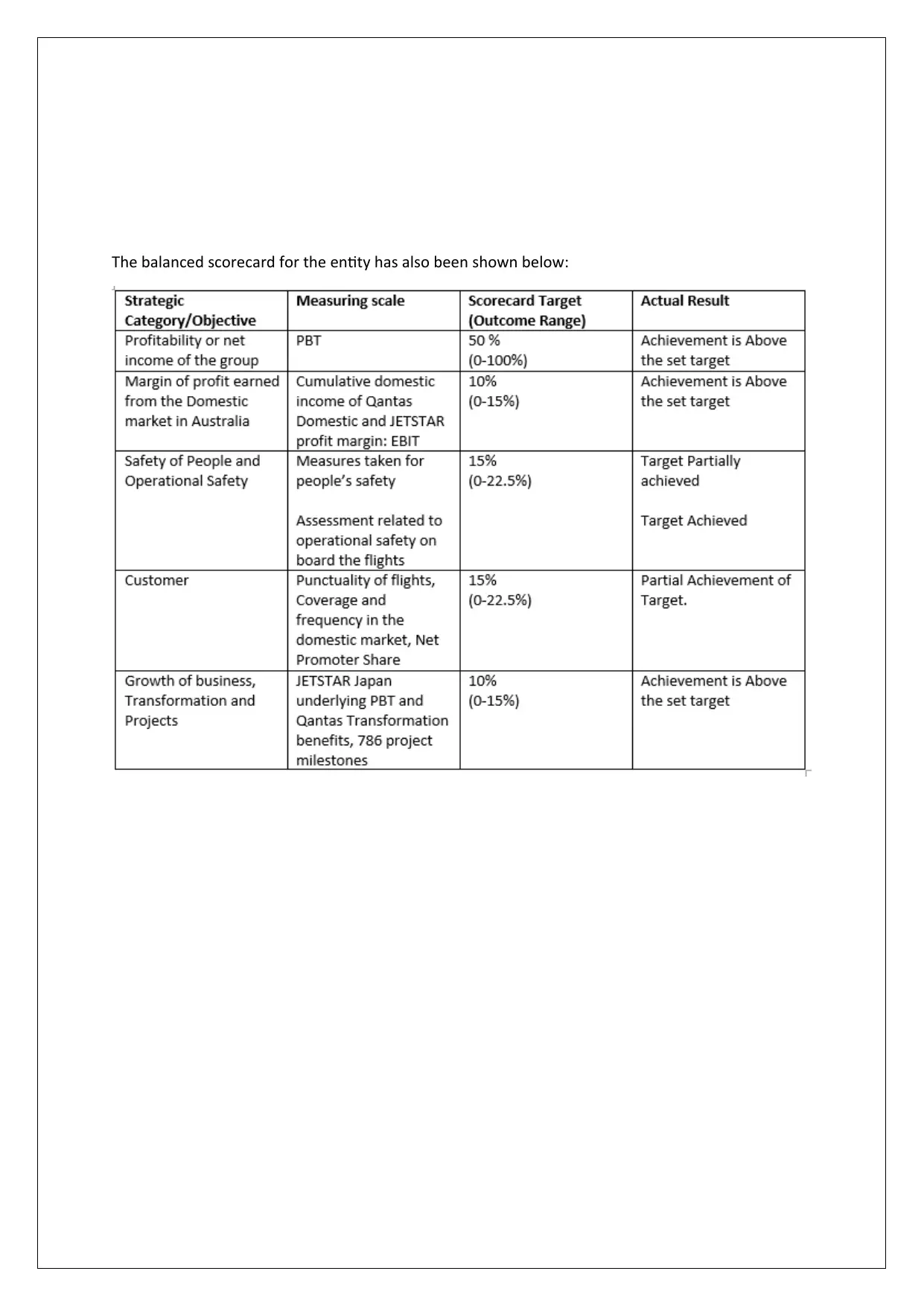
The balanced scorecard for the entity has also been shown below:

References
Arnott, D., Lizama, F., & Song, Y. (2017). Patterns of business intelligence systems use in
organizations.
Decision Support Systems, 97, 58-68.
Bromwich, M., & Scapens, R. (2016). Management Accounting Research: 25 years on.
Management
Accounting Research, 31(1), 1-9.
Dumay, J., & Baard, V. (2017). An introduction to interventionist research in accounting.
The
Routledge Companion to Qualitative Accounting Research Methods, 265. Retrieved from
https://books.google.co.in/books?
hl=en&lr=&id=PzQlDwAAQBAJ&oi=fnd&pg=PA265&dq=Dumay,+J.,+%26+Baard,+V.+(2017).
+An+introduction+to+interventionist+research+in+accounting.
+The+Routledge+Companion+to+Qualitative+Accounting+Research+Methods,
+265.&ots=ta1isTHB
Erik, H., & Jan, B. (2017). Supply chain management and activity-based costing: Current status and
directions for the future.
International Journal of Physical Distribution & Logistics
Management, 47(8), 712-735.
Heminway, J. (2017). Shareholder Wealth Maximization as a Function of Statutes, Decisional Law,
and Organic Documents.
SSRN, 1-35.
Linden, B., & Freeman, R. (2017). Profit and Other Values: Thick Evaluation in Decision Making.
Business Ethics Quarterly, 27(3), 353-379. Retrieved from
https://doi.org/10.1017/beq.2017.1
Meroño-Cerdán, A., Lopez-Nicolas, C., & Molina-Castillo, F. (2017). Risk aversion, innovation and
performance in family firms.
Economics of Innovation and new technology, 1-15.
Arnott, D., Lizama, F., & Song, Y. (2017). Patterns of business intelligence systems use in
organizations.
Decision Support Systems, 97, 58-68.
Bromwich, M., & Scapens, R. (2016). Management Accounting Research: 25 years on.
Management
Accounting Research, 31(1), 1-9.
Dumay, J., & Baard, V. (2017). An introduction to interventionist research in accounting.
The
Routledge Companion to Qualitative Accounting Research Methods, 265. Retrieved from
https://books.google.co.in/books?
hl=en&lr=&id=PzQlDwAAQBAJ&oi=fnd&pg=PA265&dq=Dumay,+J.,+%26+Baard,+V.+(2017).
+An+introduction+to+interventionist+research+in+accounting.
+The+Routledge+Companion+to+Qualitative+Accounting+Research+Methods,
+265.&ots=ta1isTHB
Erik, H., & Jan, B. (2017). Supply chain management and activity-based costing: Current status and
directions for the future.
International Journal of Physical Distribution & Logistics
Management, 47(8), 712-735.
Heminway, J. (2017). Shareholder Wealth Maximization as a Function of Statutes, Decisional Law,
and Organic Documents.
SSRN, 1-35.
Linden, B., & Freeman, R. (2017). Profit and Other Values: Thick Evaluation in Decision Making.
Business Ethics Quarterly, 27(3), 353-379. Retrieved from
https://doi.org/10.1017/beq.2017.1
Meroño-Cerdán, A., Lopez-Nicolas, C., & Molina-Castillo, F. (2017). Risk aversion, innovation and
performance in family firms.
Economics of Innovation and new technology, 1-15.
⊘ This is a preview!⊘
Do you want full access?
Subscribe today to unlock all pages.

Trusted by 1+ million students worldwide
1 out of 6
Related Documents
Your All-in-One AI-Powered Toolkit for Academic Success.
+13062052269
info@desklib.com
Available 24*7 on WhatsApp / Email
![[object Object]](/_next/static/media/star-bottom.7253800d.svg)
Unlock your academic potential
Copyright © 2020–2025 A2Z Services. All Rights Reserved. Developed and managed by ZUCOL.




